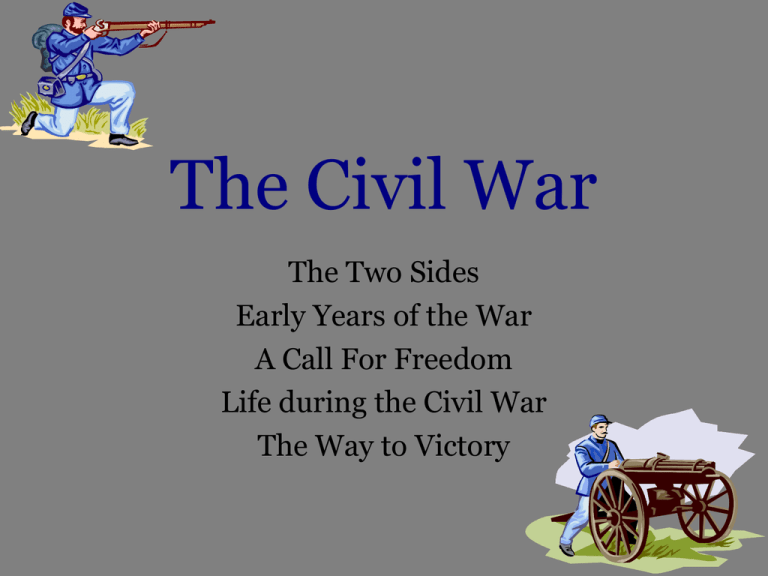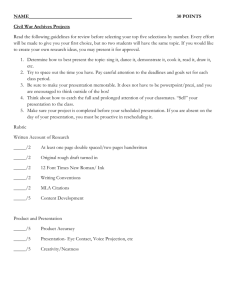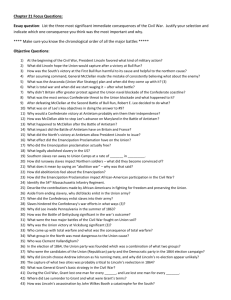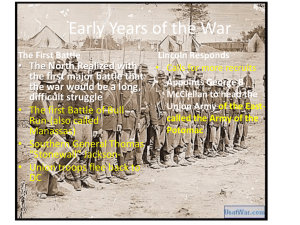The Civil War
advertisement

The Civil War The Two Sides Early Years of the War A Call For Freedom Life during the Civil War The Way to Victory The Two Sides • Choosing Sides – – – – Border States: Missouri, Kentucky, Maryland and Delaware Slave states unsure whether to join Union or Confederacy These states decide to remain in the Union Virginia splits in half when West Virginia is formed The Two Sides Northern Strengths and Weaknesses Strengths 1. Large population, more industry 2. Larger and more efficient railway network 3. Better banking system 4. More ships The Two Sides Northern Weaknesses 1. Difficult task to bring South back into Union 2. Public divided over war in North The Two Sides Southern Strengths and Weaknesses Strengths 1. Strong support from white population 2. Fight in familiar territory 3. Military leadership superior to north Jefferson Davis The Two Sides • • • • Southern Weaknesses Material disadvantages Smaller population Few factories to make weapons and supplies Less than 1/2 the railroad tracks of north The North Ulysses S. Grant Robert E. Lee VS. The South George McClellan Thomas “Stonewall” Jackson The Two Sides • • • • Northern Strategies Bring Union back together (not focused on Slavery at first) Blockade Southern ports – cut off supply lines Gain control of the Mississippi River – split confederacy Capture Richmond The Anaconda Plan The Two Sides Southern Strategies • Win recognition as an independent nation • Defend homeland by “wearing” out Union forces • South expected Britain and France to offer aid Early Years of the War The First Battle of Bull Run • Early battle fought near Manassas Junction at the Bull Run river • Although at first driven back by Union soldiers, led by “Stonewall” Jackson, the Confederates fought back • North is shocked and realize this could be a long and bloody war Early Years of the War War at Sea • Lincoln plans to blockade Southern ports • Blockade runners sail in and out of blockade • Blockade reduced southern trade by 2/3 • Monitor vs. Merrimack: First naval battle between to ironclads Early Years of the War Early Battles • Fighting stalls as each side struggles to train new recruits • Union General McClellan and his Army of the Potomac showed hesitation when faced with task of attacking in a battle • Union goal: Capture Richmond • Instead of attacking via land, McClellan approached by sea • Failed to capture Richmond Early Years of the War Early Battles Continued… • The Battle of Antietam – Confederates confident after initial victories • After finding Lee’s orders dropped accidentally in Maryland, the Union knew when, where, and how many troops to expect at the next battle • McClellan still delayed attacking and Lee was able to gather his troops • Although the Union claimed victory, Lincoln fired McClellan A Call for Freedom Emancipation – Lincoln knew ending slavery would divide the nation further – Many believe slavery keeps the South motivated because slaves are backbone of southern economy – By 1862 Lincoln had decided to Emancipate all slaves – January 1, 1863: Emancipation Proclamation A Call for Freedom Effects of the Proclamation – Since the Proclamation only effected areas controlled by the Confederacy, no slaves were actually freed – Lincoln hoped once word spread, slaves would begin to run away – Congress passes the 13th Amendment in 1865 and legally abolished slavery A Call for Freedom African Americans Help – Although southerners did not trust slaves enough to become soldiers, they became so desperate for soldiers by the end of the war that they did consider it – 54th Massachusetts Life During the Civil War The Lives of Soldiers – In the beginning both sides rushed to join war, but the enthusiasm quickly ended – Camp life was often dull between battles and sometimes the soldiers forgot what side they were on – New rifles and trench warfare made the Civil War extremely deadly – Medical facilities could not keep up with demand – Many soldiers deserted – Starving confederate soldiers often invaded an area simply because it had food that they could steal Life During the Civil War Women and the War – New responsibilities: • • • • Teachers Office workers Worked in factories Manages farms Life During the Civil War Role of Women – Some women served as spies – Some disguised themselves and became soldiers – However, most became nurses- Clara Barton – Many doctors felt nursing was too harsh for women’s nerves, or felt that they were doing men’s work Life During the Civil War Opposition to the War Two northern groups: 1. Lincoln Supporters 2. “Peace Democrats” – opposed Lincoln • Newspapers compared these democrats to poisonous snakes and nicknames “Copperheads” • Some of these Copperheads actively supported the Confederate army Life During the Civil War Declining enlistments lead to draft – As war continues, both N. and S. numbers drop – Both sides start drafting, requiring men between 18 and 35 to enlist for at least 3 yrs – A person could hire a substitute – The north tried to bribe men to volunteer, but even that failed Life During the Civil War Resistance to Draft – Riots erupted in several Northern cities – The worst in New York when angry mobs began burning, looting, and killing – The south did not experience such protests, but many tried to “dodge” the draft Life During the Civil War War and the Economy • North better able to cope with demands because of better resources • Both sides had to borrow money, increase taxes and print paper money • Northern economy actually doing well • RR traffic increase • Need for food helped farmers prosper • Production of coal, iron and clothing increased Life During the Civil War • • • • War and the Economy Southern economy suffers Southern landscape ruined Northern blockade caused shortage of essential goods Prices rose 9,000% during war The Way to Victory Southern Victories – 1862-1863: Lee’s army seems unbeatable – Battle of Fredericksburg and Chancellorsville • Although Union had larger army, Confederates were entrenched and were ready for all Union attacks • Union army regrouped and attacked again at Chancellorsville • Lee won another victory by dividing his army and attacking from multiple positions • Very deadly battle: Stonewall Jackson was killed accidentally by one of his own soldiers The Way to Victory The Tide of War Turns – Lee decides to try and invade the North – As the Union army begins to track Lee’s advancing forces they meet on July 1, 1863 in Gettysburg, Pennsylvania – Union troops surprised rebel soldiers as they were raiding the town for shoes – After three days of attacking and counter-attacking, Lee’s final bold move proved fatal when his troops were caught marching across an open field The Way to Victory Union seizes Mississippi River – Decisive Battle of Vicksburg allows Union to gain control when Confederate fort surrenders – At same time, Lincoln delivers the famous Gettysburg Address, which inspired both the Union and Confederacy Unfinished Confederate Grave The Way to Victory Final Phases of War – After losses and Gettysburg and Vicksburg, the South begins to lose ground – President Lincoln asks Ulysses S. Grant to help with the final phases of war – They plan to attack the rebel army at all fronts as once – Union General Sherman would begin his legendary march Atlanta, Georgia Union Officers Ulysses S. Grant William T. Sherman The Way to Victory The Election of 1864 – Both sides wish to negotiate for peace – Lincoln’s chances for re-election are slim because he refuses to stop until slavery is abolished and the Union and reunited – After the North began winning battles in late 1863, Lincoln easily wins re-election – Sherman captured Atlanta and South realizes the end is near The Way to Victory Total War – Leaving Atlanta in ruins, Sherman began his historic “March to the Sea” – Sherman’s army lived off the land as it tore through Georgia – They began destroying everything in their path (animals, homes, fields, RR lines) The Way to Victory Victory for the North – Early 1865, Richmond falls to Union when weak, sick rebel soldiers are unable to hold their line – Union troops burnt Richmond to the ground – Surrender at Appomattox • April 9: Lee surrenders to Grant at Appomattox Courthouse in Virginia • Terms: Lay down their arms and go home John Wilkes Booth






